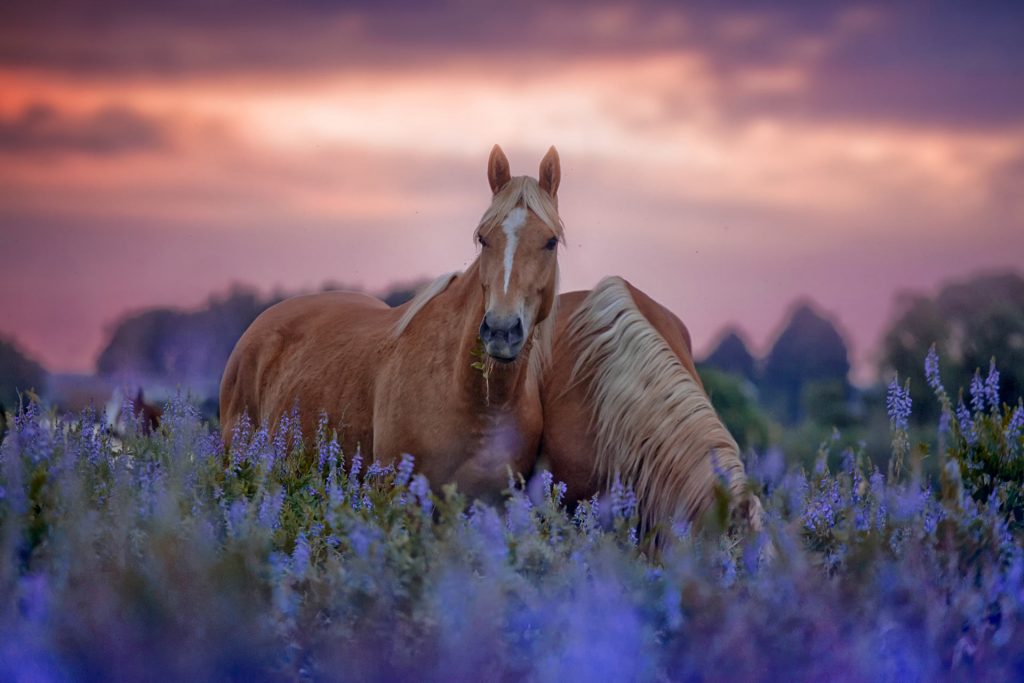I always say my horses have the final ‘nay’ when I am formulating aromatherapy blends for them. I pick individual essential oils to start with first and slowly introduce each scent, allowing the horse time to take in the aroma, all while observing their responses which come in the form of body language communication and subtle cues. Often they may only need one essential oil at a time for a specific issue with short-term use, however, there are times when a blend of a few essential oils and or different botanical bases is better suited. When a blend is made, I offer those melded scents for each horse to smell first. This type of mutual acceptance of scents is not only beneficial for your animal friend, but it also deepens your relationship by tapping into what they are expressing based on their needs.
Horses and donkeys (equids: single-hooved) along with many farm animals (cloven-hoofed cattle, goats, sheep, pigs, etc.) can benefit from the use of aromatherapy and flower essences. Horses, in particular, are quite in-tune to the use of aromatics and botanicals and will often seek out a particular scent for its healing properties. Both alpacas and llamas, though not the same type of foot as hooved animals (their feet are made of two toes (the third and fourth digits) which have a toenail and pad) can also benefit from the use of aromatherapy, botanicals and flower essences.
Some of the areas that resonate with the use of botanicals are emotional wellbeing, skin and hoof/foot care.
It may be assumed that because an animal such as a horse or cow is much larger than a dog that one should use more essential oils, yet the opposite is really all that is required. Horses have thin skin and they are also sensitive to pressure (whether that be via touch therapies, being ridden and when having a saddle and tack fitted), so care must be taken to not use too much of a good thing when applying aromatherapy blends or botanicals topically to their skin.
Safety also includes cautions in regards to certain essential oils that are high in ketone and phenol constituents (which can irritate and even burn the skin if not properly diluted or if too much is used too often). Photosensitizing type essential oils (citrus essential oils, in particular, the expressed versions of bergamot, lemon, and lime. The distilled form of these three essential oils are not considered phototoxic) should be avoided for use topically with all animals that will be exposed to sunlight (which for the most part applies to the majority of farm animals). These type of essential oils can cause a phototoxic reaction which may manifest in the form of irritation, inflammation, redness, itching, swelling, dark marks (which can remain permanently), burns, and blistering and peeling of the skin.
Please do not stress a horse that is restricted via cross-ties or confined to a stall (and unable to move away) by then jamming a bottle of pure essential oil too close or up their nostrils. This is not only invasive but just unfair to the animal whose sense of smell is much more heightened than a human’s sense of smell, and they may not like that particular scent and or associate it later on as something negative (the scent and being cross-tied, seeing an essential oil bottle, etc.). Essential oils should be introduced gently and slowly to animals and via 1 drop on a tissue or scent strip vs exposure to a bottle of potent pure essential oil (non-diluted).
Avoid placing essential oils directly onto any type of muzzle gear (such as a grazing muzzle), or onto halters which can rub and irritate the skin and mucous membranes (when placed too close to the eyes, nostrils and mouth area).
When and if diffusing essential oils in a farm facility such as a barn, be sure to follow safe use guidelines and avoid the use of placement of diffuser units directly in or too close to horse stalls. If in a horse boarding-type facility be sure to get permission from the owner and other boarders before using essential oils via diffusion as they may not allow this at their farm (due to electrical restrictions or their animal may have existing health issues that may not resonate well with exposure to scents).
